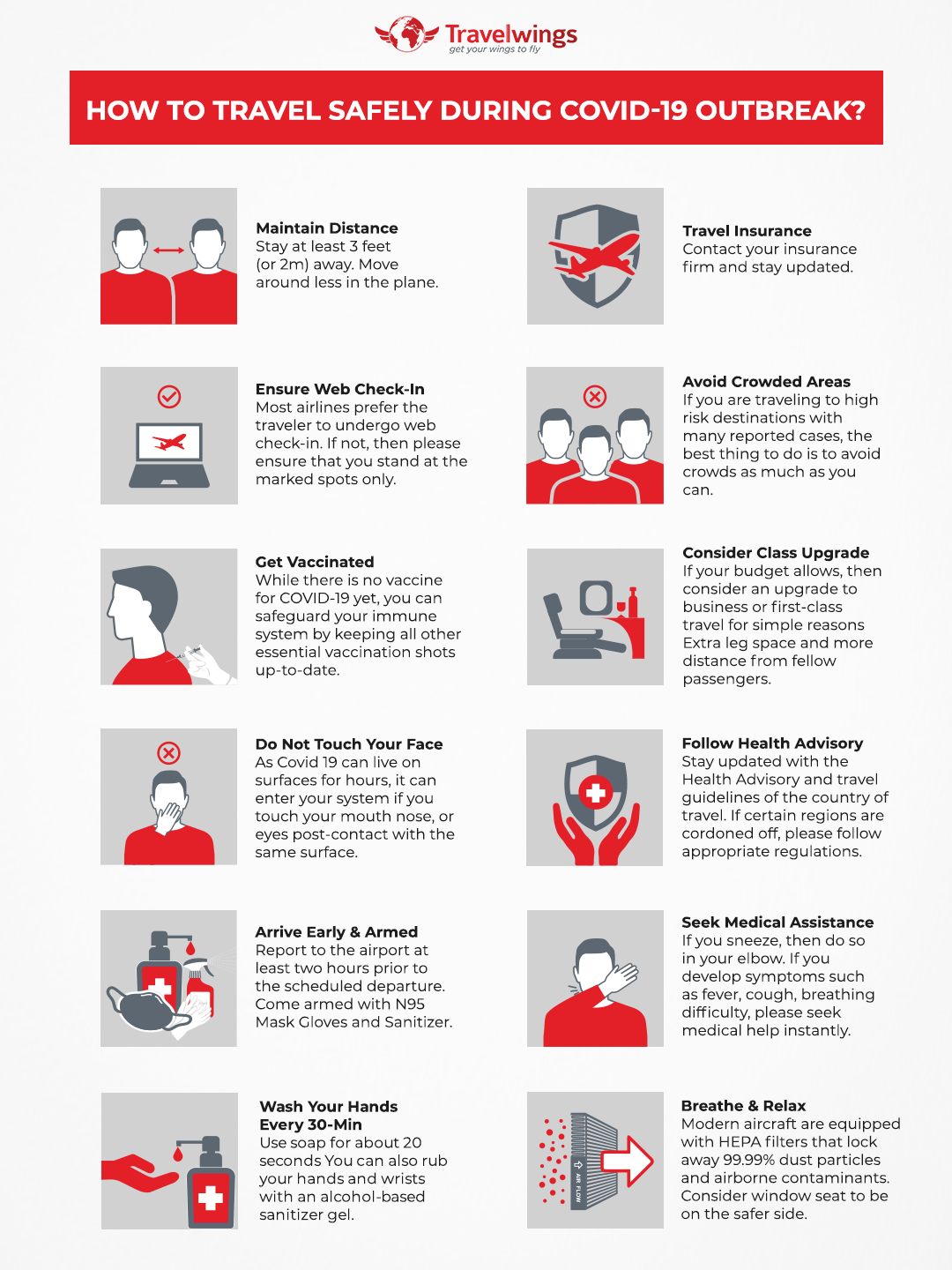

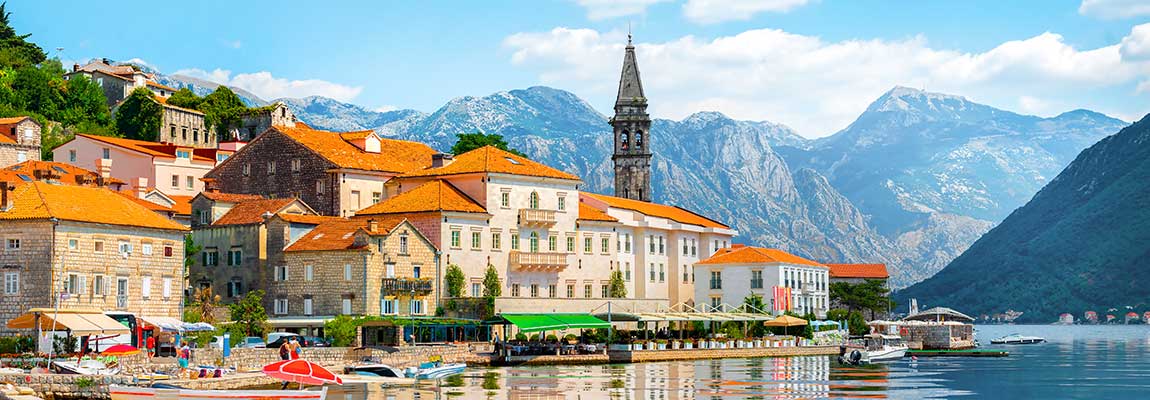

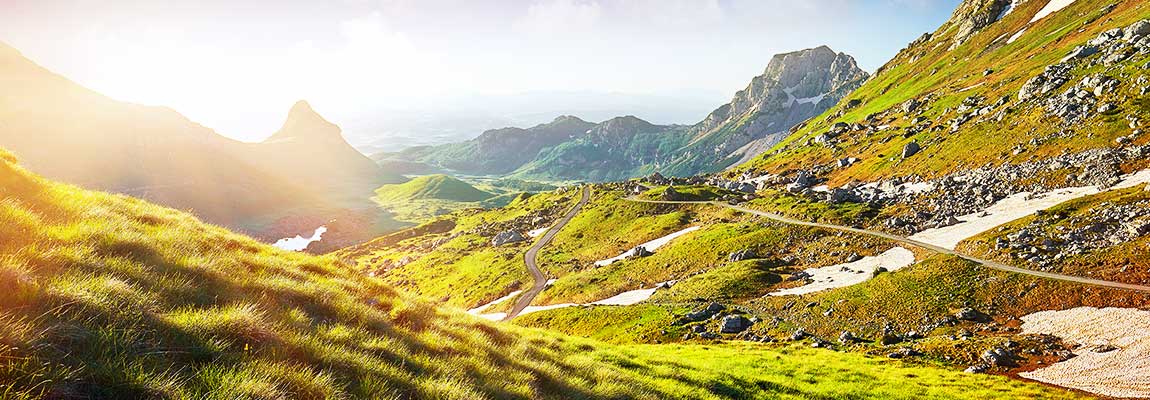
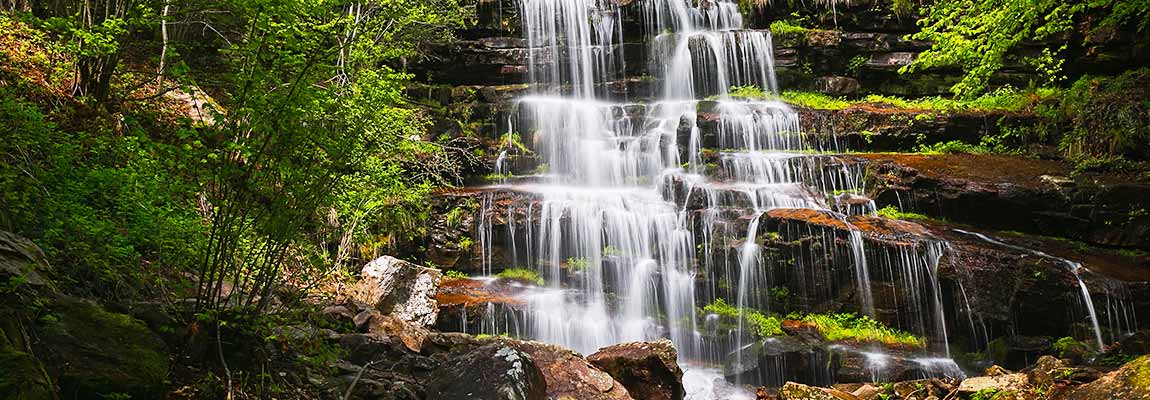
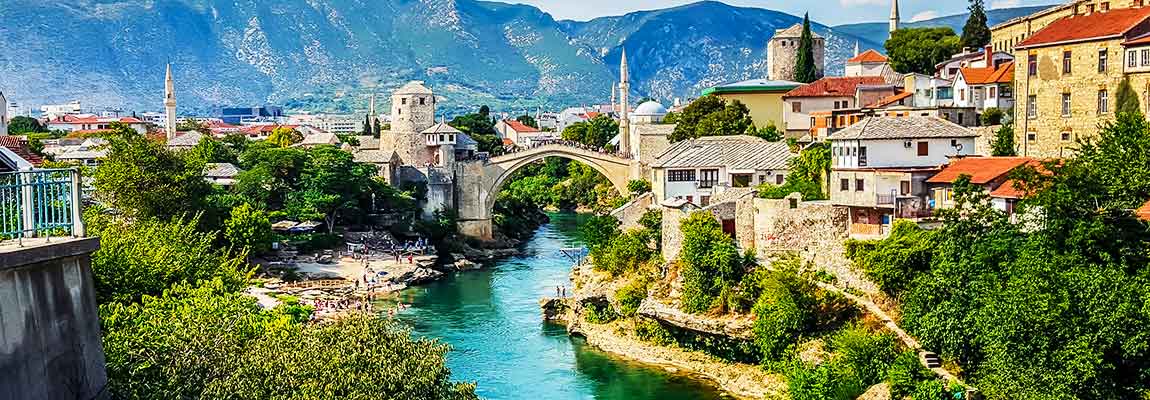
The Balkans comprises an array of landscapes, experiences, cuisines, and history. Travel to learn about the Balkan countries that include Croatia, Bosnia and Herzegovina, Slovenia, Serbia, Montenegro, Kosovo, Macedonia, Romania, Bulgaria, Albania, Greece, and the European part of Turkey. The Balkan Peninsula occupies a large part of southeastern Europe from the Balkan Mountains between Serbia and Bulgaria, all the way to the Black Sea. Our guide provides a nice overview of the Balkan attractions to discover, in the many countries in that part of Europe. Be open to embracing the myriad cultures and local customs on this incredible Balkans tourism with the help of this comprehensive guide.
Neighbouring places: Italy, Hungary, Moldova, Ukraine, Turkey, Aegean Sea
Famous For: Acropolis | Plitvice Lakes National Park | Meteora | Parthenon | Krka National Park | Acropolis Museum | Bran Castle | Lake Bled | Myrtos Beach | Golden Horn (and other attractions)
National Symbols: National Flag (12 countries) | National Animal | National Emblem | National Anthem
Time Zone: GMT +1
Ethnicity: Serbs and Croats, Montenegrins, Bosniaks, Slovens, Macedonians
Driving Side: Right
Airports in Balkans: Athens International Airport | Tirana International Airport Nene Tereza | Kukes International Airport | Losinj Airport | Sofia International Airport | Thessaloniki International Airport | Belgrade Nikola Tesla Airport | Rhodes International Airport | Pristina International Airport | Zagreb International Airport | Corfu International Airport and others
Network ConnectivityThe top five Balkan countries that provide the fastest internet are Romania, Bulgaria, Serbia, Macedonia, and Montenegro. Listed are the internet service operators in some of the countries in the Balkans.
SerbiaThe major internet service providers are Telekom Srbija, SBB, Telenor, and Vip mobile among others. The internet is available in various forms such as DSL, wireless, fiber, and cable. Vip Mobile, Telenor and Telekom offer prepaid internet with SIM cards. There are tailor-made packages to choose from with good coverage and speed across the country. Most hotels and public areas offer free Wi-Fi internet access. Choose a Visitor SIM package with 10 GB internet speed and 14 days validity at $10.24 approximately.
CroatiaA reliable internet access provider is RoamFree Ninja. You can use the device anywhere in Croatia. Travel with a small device and you are online on the go. The pocket-sized router can connect to 10 different devices at the same time. A ninja package includes 20 GB of data that is sufficient for a traveller. You can get RoamFree Ninja delivered before your departure. Ninja's pricing starts at $9.67 per day. Tele2 Surf and Call Sim cards can be picked up at the airport with packages available. T-mobile Unlimited Internet sells SIM cards with a 7-day usage flat rate at 4G speed. Check the websites for pricing and packages that are updated.
GreeceWIND.gr, Vodafone and Cosmote offer competitive packages with 3G connectivity in most areas. You could purchase a prepaid plan from Cosmote for $6.09 at the Germanos store. The multinational chain of electronic vendors is easily available. You can take a package that provides 1000 MB per month of free data use. Identity of passport is required during the purchase of SIM cards, so keep a photocopy handy.

About 3000 years ago, the Greeks were among the first to move south of the Balkans. In the early Christian centuries, there was a movement of people when the Goths, Huns and the Slavs passed the peninsula. Some of them settled in the region. The Balkans became a cluster of countries such as present-day Serbia, Romania, Albania and more. They were ruled by the Ottoman Empire and the inhabitants were known as Slavs. There was a large-scale spread of nationalist movements in Europe. In 1912 Russia influenced several of the Balkan nations and signed a military pact. The Balkan League was formed with a mission to overthrow the Ottomans and take control of eastern Europe. The First Balkan War lasted for eight months and on 30 May 1913, a Treaty of London was signed.
The Second Balkan War was due to a rivalry between Bulgaria and former allies Serbia and Greece in 1913. Serbia and Greek armies attacked and entered Bulgaria. Romania was also at war, and the bulk of Balkanian forces were engaged in the south. The Ottoman Empire took advantage and tried to regain some lost territory from the previous war. The war ended with the signing of the Treaty of Bucharest, in which Bulgaria lost portions of its First Balkan War gains to Serbia, Romania and Greece. Romania lost Edirne to the Ottomans in the Treaty of Constantinople.
Most of the Balkan nations gained independence from the Ottoman Empire or the Austro-Hungarian rule. During the 19th century and early 20th century, independent countries were formed. Greece got independence in 1821, Bulgaria in 1908, Serbia and Montenegro in 1878 and Albania in 1912. Most of the Balkan states had rivalry amongst themselves, and that gave way to the European powers. Austro-Hungary, Germany and Britain wanted to extend their influence in the region. This led to a series of wars known as World War I.
The Balkan Peninsula, also called the Balkan states, consists of Croatia, Bosnia and Herzegovina, Slovenia, Serbia, Montenegro, Kosovo, Macedonia, Romania, Bulgaria, Albania, Greece, and the European part of Turkey. Some of the Balkan countries such as Croatia, Slovenia and Macedonia were once part of Yugoslavia.
The geography of the Balkans indicates that the peninsula is bordered by Italy on the northwest, Hungary on the north and Moldova and Ukraine on the northeast, Greece and Turkey or the Aegean Sea (depending on how Balkan geography is defined) in the south. The Balkans are surrounded by the Adriatic Sea in the west, the Black Sea in the east and the Ionian Sea in the southwest. The north borders are not demarcated due to the Pannonian Basin of the Great Hungarian Plain. It extends from central Europe to parts of Serbia, Romania and Croatia.
The Balkans is also known as the Balkan Peninsula. It lies in the easternmost region of Europe. The Balkans comprises Croatia, Bosnia and Herzegovina, Slovenia, Serbia, Montenegro, Kosovo, Macedonia, Romania, Bulgaria, Albania, Greece, and the European part of Turkey. There are different interpretations among historians and some define the region in cultural and historic terms.
More often, Slovenia is included in the Balkans due to historical ties with its neighbours. Greece and Macedonia also appear as Balkan states and are characterised as Mediterranean countries. Turkey in Europe or European Turkey is numbered among the Balkan countries, and the Ottoman Turks have cast strong political dominance in the region.
Some of the mountains in the region include the Balkan Mountains in the east-west of Bulgaria, the Dinaric Range that extends down the Adriatic to Albania. The northern boundary consists of the Carpathians and the Julian Alps. The arable land is good in the valleys of the Danube, Sava and Vardar Rivers, the Danube plains and the land by the Aegean Sea coast. The mountains have contributed to the fragmentation of ethnic groups, and hence the Balkanization.
Balkans’ culture is influenced by the Balkan people who are passionate about art and express their talents for centuries. They are known to make amazing handwork out of wood, metals, and stones. Woven carpets and rugs with beautiful decorations are also a skill mainly of the Balkan women. Look out for handmade ceramic containers, pots, plates and ceramic glasses as you taste the amazing traditional Balkan food. Balkan culture is all about the tough historical past that has been collected over the years.
Balkan music is typical of the southeastern Europe region. The famous bands played music characterised by complex rhythms. Greek folk music is famous in the Greek mainland and islands while Crete is well known for the folk-dance tradition. Lira, guitar, mandolin, clarinet are some of the popular instruments of the region. Music is associated with different Balkan countries and is influenced by their national identity and cultures.
Food and DrinkBalkan dishes are diverse and spicy with common ingredients such as hot peppers and pickled vegetables. Fill your stomach with the famous grilled meats and coastal cuisine. The culinary experiences include influences from the Mediterranean and Middle East cultures. There are a lot of similarities that come together in a Balkan diet and you can pick from a wide range of Balkan food.
Must-Try Balkan National DishesCevapi (skinned sausages with ajvar and chopped onions), Dolma (grape leaves stuffed with tomatoes, zucchini or bell peppers), Fis Paprikas (spicy fish stew), Pljeskavica (patty made of lamb, pork, beef or veal), Shopska Salad (cucumbers, onions, tomatoes, peppers and feta cheese), Grilled Meat and Fish, Cobanac (meaty stew)
Must-Try Balkan National DrinksRakija (an alcoholic beverage made from fruits), Pelinkovac (wormwood liqueur), Ayran (yoghurt drink), Bankya (mineral water), Turkish Coffee, Bulgarian Wine, Boza (a beverage made of wheat, rye or millet), Green Menta (beverage from spearmint oils), Elderberry Juice (homemade beverage), Etar (carbonated soft drink)
HospitalityThe Balkans are nice and friendly to travellers. They tend to be curious towards visitors and suspicious towards outsiders. Balkan people rely on fortune-telling and hang a blue glass eye or red thread tied around their wrist. They take pride in their homemade alcohol and if you are invited to a local home, you will be welcomed with a glass of plum or grape distilled spirit. A holiday among hundreds of people who live life leisurely sipping coffee or just people watching. They talk in loud tones and are sensitive to topics on nationalism.
The best time to travel to the Balkans is April to June and September to November. These are the shoulder seasons when the weather is mild and popular cities are not crowded. The summer months from July to August sees tourists crowd the spectacular beaches. If experiencing festivals is on your cards then this is the season to visit. However, the summer months are warm, especially in the inland cities. Travel between December to March for world-class skiing in the Balkans. Experience the Christmas markets in Zagreb that are world-famous and embrace the spirits of the holiday season. Weather patterns vary as the region is diverse throughout all the countries. However, expect a continental climate with cold winters and hot summers. The summer months of March to May and September to November should be your best bet. You experience an average high of 30°C but the islands can get as hot as a maximum of 40°C in August.
The Temple in Athens, Greece is one of the top Balkan attractions. The spectacular former temple on the Athenian Acropolis is dedicated to the goddess Athena. The construction started in 447 BC of the ancient citadel that is located on a rocky outcrop in Athens. The popular attraction is a symbol of Athens' democracy. It was built after the victory of the Persians and symbolises Athens cultural superiority.
Best Time to Visit: March to May and September to November
Entry Price: $22 (one day ticket per person)
This is one of the best-preserved Balkan attractions in Pula, Croatia. It is the only Amphitheatre that has all its four side towers preserved. The building was built in the 1st century AD and is also called the Arena of Pula. Its rival is the Colosseum in Rome in terms of popularity. The Amphitheatre hosts popular music festivals and classical concerts that take place here. Explore the beauty that is among the world's six largest Roman arenas.
Best Time to Visit: Mid-April to May and mid-September to mid-October
Entry Price: $8.09 (adult), $4.05 (children / students)
Visit the Eastern Orthodox monastery in Bulgaria founded in the 10th century by St. John of Rila. It is a cultural site in the Rhodope Mountains and is one of the most popular Balkan attractions. The historically significant site attracts plenty of visitors. Get great views of the mountainous landscapes from the monastery. The Rila complex is a 73 miles bus ride away from Sofia and symbolises Slavic cultural identity.
Best Time to Visit: Winter season (to experience the snow-covered magic of the monastery)
Entry Price: $4.86
Visit the natural wonder and one of the oldest lakes in Europe. The lake is an escape from the bustling Balkan cities and stretches down 900 feet deep. It straddles Macedonia and Albania and is located in the city of Ohrid. Take a relaxing boat ride and explore the historical churches around the lake. This is an ideal place to spend a quiet day with family.
Best Time to Visit: June to August
Entry Price: Based on the tour
Be awe-struck by the stunning landscapes of the national park in Albania. The Park offers massive valleys and hiking trails for adventure lovers. You can swim in the Grunas Waterfall which is a 98-foot-high natural beauty. Visit the Lock-in Tower that used to protect people from bloody feuds that took place in the region.
Best Time to Visit: Summer season
Entry Price: Based on the tour
The popular attraction in Croatia is a beach that changes its shape. This beautiful long pebble beach is a natural wonder. It stretches into the Adriatic Sea and is a popular spot for holidaymakers. It is also referred to as the Golden Cape or Golden Horn Beach. The huge V-shaped beach offers beautiful sunsets and perfect postcard views.
Best Time to Visit: May to October
Entry Price: $61.98
Most Popular Regions and Cities to Visit in the Balkans
CroatiaCroatia is a super trendy place made popular by Game of Thrones tourism. The Croatian charm from its long coastline to architecture and cuisine is inviting. There are multiple UNESCO World Heritage Sites along the Croatian coast. Sip on calamari and white wine by the seaside or enjoy the array of attractions, this is a fashionable Balkan country to visit.
Visit For: St. Mark's Church, Zagreb Cathedral, Plitvice Lakes National Park, Krka National Park
GreeceMainland Greece with its amazing historic sites and architectural marvels is a top destination. The Greek islands offer some of the most beautiful beaches in the world. From the architectural attractions of Meteora, spectacular views at Delphi to wonderful sunsets on the Greek island, a trip to Greece is always a bucket list idea.
Visit For: Santorini & Mykonos, Parthenon, Acropolis, Temple of Apollo, Temple of Poseidon, Meteora, Parthenon
KosovoKosovo is one of the newest countries in Europe with picturesque streets, Kosovo Mountain views and animal sanctuaries. The capital Pristina has tonnes of cafes, restaurants and shopping opportunities. There are plenty of mosques, churches and monasteries. See one of the World's Ugliest Buildings, the National Library of Kosovo. The country offers many attractions such as Lake Ohrid, Matka Canyon, St. Andrew's Monastery among others.
Visit For: Ethnographic Museum, Mother Teresa Cathedral, Germia Park, Newborn Monument
MontenegroFall in love with Montenegro especially if you are a nature lover. The charming town offers some fabulous bay views and it lies on the Bay of Kotor. The Black Lake, stunning Tara Canyon and Dobrilovina Monastery are some of the top attractions. White water rafting in Tara Canyon or exploring the Durmitor National Park are some of the top things to do.
Visit For: Ostrog Monastery, Our Lady of the Rocks, Bay of Kotor, Lake Skadar, Tara River Canyon
SerbiaSerbia is a fairy tale paradise with landscapes and unique experiences. Visit Belgrade, the capital built at the confluence of the Sava and the Danube. The city has a deep cultural and historical heritage. It is called the "gateway to the Balkans" rightfully. Visit a large number of museums, monuments and cultural centres. Experience gastronomy in the culinary festivals that bring together hundreds of people.
Visit For: Tara National Park, Zajecar National Museum, Church of St. Sava, Museum of Yugoslav History
If you have time some of the other famous countries are :The famous trumpet festival happens in the small town of Guca. It draws music lovers from all over the world. Fans come and spend a week in Guca located near the city of Cacak. This fun Serbian festival looks like one big fair of traditional food and trumpet performances.
Location : Guca, Serbia
Date : August
This music festival takes place in Copacabana Beach on Montenegro's coast. DJs, artists and musicians come together to play jazz, electronic music and more. This appealing festival is chilled-out with several stages set upon the golden sandy beaches.
Location : Copacabana Beach, Montenegro
Date : End June
This is a four-day non-stop party with a line-up of famous artists. The music festival happens in the summer of August in Serbia. There are several dance floors and musicians play electronic music genres. Martinez Brothers, Jane Fitz, Rodhad are some of the artists who perform.
Location : Serbia
Date : August
The festival started in the 90s and takes place in the Hungarian capital, Budapest. You get to witness international electronic, pop, jazz, folk, Roma music and more. Music fans relax and enjoy the summer by the Danube River. You have a famous line-up of David August, Michal Kiwanuka, Years & Years among others at the festival.
Location : Hajogyari Island, Budapest
Date : August
The Belgrade Beer Festival has entire sections dedicated to top class craft beer. The Belgrade festival also has some of the finest bands of musicians who feature their art. This is an annual event that happens in August. The festival began in 2003 and is held for five days. You get a lot of international and local beer brands to try along with exceptional music programs.
Location : Belgrade
Date : August
All travellers must have a valid passport to apply for a Balkans visa. The passport needs to be valid for at least 90 days beyond the date of entry. The passport must have at least two consecutive blank pages for each country of travel for a Balkans' visa requirement.
Visa-on-arrival/eVisa/Visa free entryTravellers who have multiple Schengen visas or European Union state visas or residence permits of the Schengen Agreement country or EU member state get Balkans visa-free entry.
The 26 countries that make up the Schengen Area do not require a visa for travel to the Balkans for a 90 days limit. Citizens of the following countries can freely travel within the Schengen Zone from any of the member countries. The countries are;
Citizens of the US, Canada, UK, Mexico, Australia, Japan and other countries also are permitted to enter without a visa for up to 90 days within six months. The list of countries that are not part of the Schengen region but belong to the EU that are allowed visa-free entry include;
The following countries who are not a part of the Schengen Area but allow foreign citizens to enter by showing a valid Schengen visa (double or multiple entries) for short stays of up to 30 days or 90 days in any of the 180 days are;
Reach out to the embassy of the country of travel with valid documents to apply for a Schengen visa or other relevant visas. You can download the visa application form and submit all documents required with the standards set by the embassy where you are applying.
Types of Visa and ValidityYou can apply for the Uniform Schengen Visa that permits travel to the countries part of the Schengen Area. The maximum duration of stay is 90 days for every stay up to 6 months commencing from the date of arrival. Category A is for an Airport Transit Visa for travellers to pass through the airport of the Schengen country. Category B is a Transit Visa that allows commuting through the Schengen country that cannot exceed 5 days of stay. Category C provides single entry visa, double-entry visa and multiple entry visas.
There are regular flights that connect the major cities in the Balkan region. Adria Airways, Air Serbia, Croatia Airlines, Montenegro Airlines, Trade Air are some of the airlines in the Western Balkans. You can fly from Ljubljana to Podgorica, Zagreb to Dubrovnik, Podgorica to Belgrade, Spilt to Pula and Dubrovnik and more. You can get schedules of flights and networks via the Skyscanner to choose the best option.
BusThis is good transport to get around with reasonably priced tickets. The coverage of the region is also comprehensive with frequent departures. There may be delays in the border crossings if you are heading towards the coast in the summers. You can buy bus tickets at large stations or book ahead to be sure of your seats. Be aware that bus services decrease at weekends and may not be available on Sundays. There are useful websites such as www.busticket4me.com, www. Vollo.net, www.getbybus.com that you could use. There are privately run minibuses (furgon) in Albania that run only when full and you can pay while onboard. Furgons have very limited bag space, a point to remember.
BicycleBicycle experience varies between regions and depends on the road conditions. In Slovenia, cycling is a popular mode of transport while in Albania the road conditions are poor. Bike lanes are available in a few cities. Remember that wearing a helmet is compulsory for children in Croatia and Slovenia. Keep an eye on a map and the contours of the land. Major cities offer bike hire facilities, especially in tourist towns.
BoatWater taxis are common in Croatia and Montenegro, especially in touristy towns. There is an extensive ferry network in Croatia with hubs in Dubrovnik and Split. Zadar, Sibenik and Rijeka are also hubs for ferry transport.
Car and MotorcycleDiscover the region by car as you drive around the region. It is good to obtain an International Driving Permit that is recognised in most countries in the region. A Green Card is insurance proof in specified countries in Europe. You will be asked for it to cross borders or by the police if you use a rental car. The Green Card also often includes the cost of car hire and you can pay the extra if the car rental company asks for it. Check the list of countries the Green Card Insurance system covers before using it. The car rental company will help you with that. Balkan Rent a Car, Balkan PMS and others are some of the rental car companies you can hire from.
RailTake an adventurous train ride and explore the Balkans, an ultimate travel experience. A Eurail Select Pass or Eurail Global Pass will make it easy for you to traverse the region by rail. The over 1000 km of rail tracks interconnects the Balkans and a rail holiday is worth your money. You can opt for a railway holiday journey and travel via a travel tour guide. The Bar to Belgrade line is a star attraction covering 11 hours of gorges, snow-laden mountains and canyon-crossing bridges. Join a small group to avoid the hassles of unreliable train services. Group tours ensure that you have a fixed itinerary designed just for you. Take along a rail journey travel guide and maps so you explore the most dramatic locations.
Get to the Balkans flying with several European budget airlines that connect to many destinations. Wizz Air will fly you inexpensively to Sofia, Tuzla and Skopje. There are below-cost airlines such as Wizzair, Easyjet and Ryanair to the Balkans. Most important European destinations such as Hungary, Denmark, France, Sweden, Berlin, Poland, Netherlands and more have flights that serve the Balkans. There are major Balkan airports to fly into in Dubrovnik, Tuzla, Rijeka, Belgrade, Pristina, Zadar and more. Along with low-cost airlines, other major airlines cater to the region. Belgrade is connected to major U.S departure points and have flights from Chicago, Washington, LA, and more. Lufthansa, Delta, British Airways, United, Air Canada, KLM are some of the major airlines servicing the region.
However, the biggest problem is transport from the airport that are expensive and irregular or non-existent. Find a taxi or rent a car with a driver and haggle the prices. There are also bus and train connections you can browse for.
Via RoadCrossing the borders is not a hassle with a queue to encounter at some stops. The borders can be crossed by car, bus or even by simply walking. The only border that is tricky is Kosovo as Serbia does not recognise it as an independent country. When you enter Kosovo from any other country except Serbia, it is considered illegal. You can carry a national ID to avoid trouble. Bus connections can be checked via the BalkanViator website to help you with schedules and prices. Passports are stamped for entry and exit at border crossings if you are travelling overland. Please be aware of custom and road rules while travelling by road.
Via RailA great way to travel to the Balkans is by rail. Get a rail pass to match the countries you wish to travel to, a guidebook and route maps. You can figure out which is the best one to buy among the many such as Balkan Pass, Serbia Eurail Pass, Romania Eurail Pass and more. Buy point to point tickets with reservations online and look up train schedules. Belgrade is connected well to major European cities and you could use Belgrade as a base. Buy a full pass and journey to extend for several days for a full-on European train adventure.
Hungary with its thermal springs, the Danube River, Buda Castle and museums is a top tourist destination. Visit the Great Market Hall, Cave Bath, Dohany Street Synagogue and other fabulous attractions.
Moldova (499.2 km from Romania)Be fascinated by the Orange Pyramid, discover the best art in the art market and witness Pushkin Park. This and more await you when you travel to Moldova. Sandwiched between Ukraine and Romania this independent republic is a country that relies heavily on agriculture. The country is best known for its wine and wineries.
Distance Between Places Of Importance In And Around BalkansUkraine - 796 km from Romania
CALLING CODE: +385 (Croatia), +381 (Serbia), +355 (Albania), +30 (Greece), +383 (Kosovo), +386 (Slovenia), +389 (North Macedonia)
EMBASSY Of UAE in GREECE: +30 210 677 02 20 | For more info Embassy of UAE in Greece
Fire brigade: 128 (Albania), 112 or 193 (Croatia), 199 (Greece), 193 (Serbia)
Ambulance: 127 (Albania), 112 or 194 (Croatia), 166 (Greece), 194 (Serbia)
Police: 129 (Albania), 112 or 192 (Croatia), 100 (Greece), 112 or 192 (Serbia)
General Emergency Number: 112
Slovenia and Montenegro are the only two countries in the entire Balkan peninsula that use the Euro as the Balkan currency. Croatia uses the kuna, Bosnia and Herzegovina use the convertible mark, and more. There are exchanges of currency counters at every border crossing which are a rip-off. Use the local exchange offices away from the border for currency exchange. Try and take out a budget before travel and carry with you the local currency of the country. We list the currency of some of the popular Balkan countries;
Croatia Currency:Kuna is the currency in Croatia. The currency code for kuna is HRK. The kuna currency symbol is kn. The kuna exchange rate for some of the popular currencies are:
Symbol: kn
Code: HRK
1 HRK = 11.84 INR (Kuna to Indian Rupees)
1 HRK = 0.52 AED (Kuna to AED)
1 HRK = 0.16 USD (Kuna to USD)
Kuna banknote denominations of 5, 10, 20, 50, 100, 200, 500, 1000 (rare)
Lipa coins denominations of 10, 20, 50, 1, 2, 5
Greece Currency:Greece's currency is the Euro, and the currency code is EUR. The Greece currency symbol is ⬠and Greece money is broken up into 100 cents. Greek Drachma is an ancient Greek currency used during the 10th century that became obsolete in 2002.
Symbol: €
Code: EUR
1 EUR = 196.12 PKR (Greece currency to PKR)
1 EUR = 87.97 INR (Greece currency to INR)
1 EUR = 4.33 AED (Greece currency to AED)
Euro banknote denomination: 5,10, 20, 50,100, 500
Euro bank coin denomination: 1, 2, 5, 10, 20, 50
Serbia Currency:Serbian dinar is the currency in Serbia. The currency code for Serbian dinar is RSD. The Serbian dinar currency symbol is din. One dinar is subdivided into 100 paras. The Serbian dinar exchange rate, for some of the popular currencies, are;
Symbol: din
Code: RSD
1 RSD = 0.75 INR (Serbian dinar to Indian Rupees)
1 RSD = 0.038 AED (Serbian dinar to AED)
1 RSD = 0.010 USD (Serbian dinar to USD)
Serbian dinar banknote denomination: 10, 100, 1000, 50, 500, 200, 20, 2000
Serbian dinar bank coin denomination: 1, 2, 5, 10, 20
Some of the other important Balkan countries have the following currencies; Albanian lek (Albania), Romanian leu (Romania), Macedonia denar (Macedonia).
Please note that Traveler's Cheques are NOT accepted in most places. The ROE is subject to currency fluctuations.